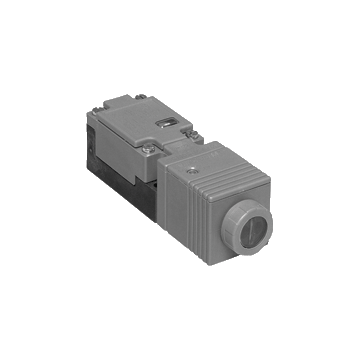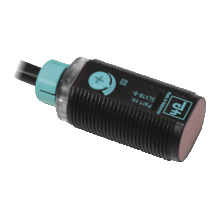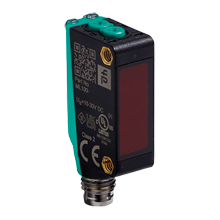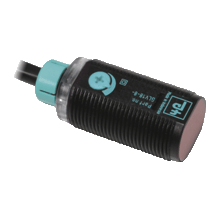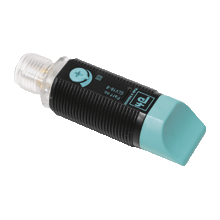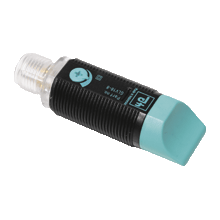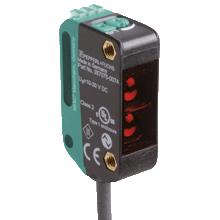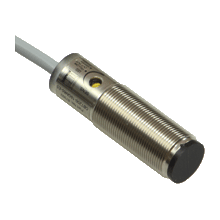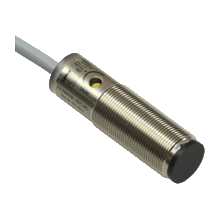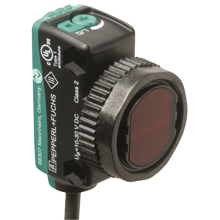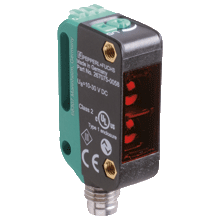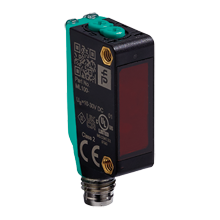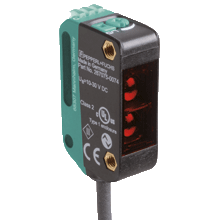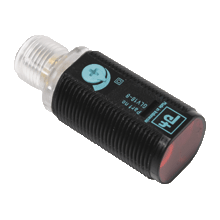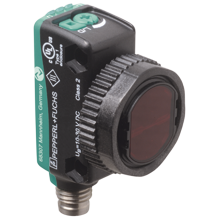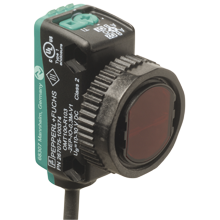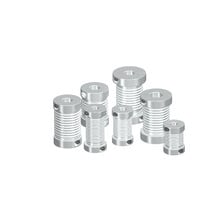OCT300-M1K-N2 - 106541
Czujnik optyczny odbiciowy firmy Pepperl+Fuchs, zakres 0 ... 200 mm, IRED, 880 nm, zasilanie 10 ... 30 V DC, klasa 2, przewód 2 m, 1 wyjście Push-Pull, jasno/ciemno-włącz, 500 Hz, -25 ... 55 ° C, IP67
Parametry produktu
Czas dostawy gdy brak na magazynie
1 tydzień gdy dostępny w PF Niemcy
Gwarancja
12
Producent
PEPPERL+FUCHS
Opisy produktu
Najważniejsze parametry Diffuse mode sensor, NAMUR OCT300-M1K-N2
- Zatwierdzenie ATEX, IECEX dla strefy 20 (Pył) i strefy 1 (Gaz)
- Iskrobezpieczny, Ex op isa IIC T6 Gb / IIIC T 135 ° C Da
- Regulowana głowica czujnika
- Odporna na zarysowania soczewka ze szkła mineralnego
| Opis produktu |
|---|
| Czujnik odbicowy, NAMUR, specjalna konstrukcja, zasięg detekcji 300 mm, światło podczerwone, włączanie / wyłączanie światła, wersja DC, wyjście NAMUR, przedział zaciskowy |
| Ogólne specyfikacje | ||
|---|---|---|
| Zasięg wykrywania | 0 ... 300 mm | |
| Zakres regulacji | 70 ... 300 mm | |
| Cel referencyjny | standardowy biały 200 mm x 200 mm | |
| Źródło światła | IRED, 880 nm | |
| Rodzaj światła | modulowane światło podczerwone | |
| Limit światła otoczenia | ≤ 40000 Lux światło słoneczne ≤ 30000 Lux światło halogenowe |
|
| Wpływ temperatury | ≤ 0,5 mm / K | |
| Parametry związane z bezpieczeństwem funkcjonalnym | ||
| MTTF d | 1319 a | |
| Czas misji (T M ) | 20 a | |
| Pokrycie diagnostyczne (DC) | 0 % | |
| Wskaźniki / środki operacyjne | ||
| Wskaźnik funkcji | Żółta dioda LED: stan przełączania | |
| Elementy sterujące | Regulator zasięgu wykrywania | |
| Specyfikacje elektryczne | ||
| Napięcie robocze | 6 ... 20 V DC (R i około 0 Ohm) | |
| Sinusoida | 5 % | |
| Opóźnienie czasowe przed dostępnością | 20 ms | |
| Wyjście | ||
| Rodzaj przełączania | jasno / ciemno włączone, programowalne | |
| Wyjście sygnału | 1 NAMUR wyjście NC / NO programowalne | |
| Napięcie przełączania | 8 V DC (R i ok. 1 kΩ) | |
| Częstotliwość przełączania | ≤ 100 Hz | |
| Zużycie prądu | ||
| Wykryto cel referencyjny | połączenie 1, 2: ≤ 1 mA, połączenie 3, 4: ? 2,7 mA | |
| Nie wykryto celu odniesienia | połączenie 1, 2: ? 2,7 mA, połączenie 3, 4: ≤ 1 mA | |
| Czas odpowiedzi | 5 ms | |
| Powtórz dokładność | ≤ 0,5% zakresu wykrywania | |
| Dostosowanie | ||
| Standard produktu | EN 60947-5-2 | |
| Zgodność ze standardami i dyrektywami | ||
| Standardowa zgodność | ||
| Standardy | EN 60947-5-6: 2000 | |
| Aprobaty i certyfikaty | ||
| Zatwierdzenie FM | ||
| Zatwierdzony dla | IS / I,II,III / 1 / ABCDEFG / T5 - 116-0110; Entity NI / I / 2 / ABCD / T6 Entity Parameters: VMax = 12.6 V, IMax = 20 mA, Ci = 1.11 µF, Li = 0 mH (Groups A, B, C, D, E, F, G). VMax = 15.5 V, IMax = 52 mA, Ci = 1.11 µF, Li = 0 mH (Groups C, D, E, F, G). |
|
| Zatwierdzenie CSA | ||
| Zatwierdzony dla | Class I, Division 2, Groups A, B, C and D Rated 20V (max), 50mA. These sensors are suitable for installation in (or through the wall of) a suitable enclosure with provision for connection of rigid metal conduit, as acceptable to the local inspection authority having jurisdiction. |
|
| Zatwierdzenie CCC | Zatwierdzenie / oznakowanie CCC nie jest wymagane dla produktów o napięciu ≤36 V. | |
| Warunki otoczenia | ||
| Temperatura otoczenia | -25 ... 70 ° C (-13 ... 158 ° F) | |
| Temperatura przechowywania | -40 ... 80 ° C (-40 ... 176 ° F) | |
| Specyfikacja mechaniczna | ||
| Szerokość obudowy | 30 mm | |
| Wysokość obudowy | 30 mm | |
| Głębokość obudowy | 102 mm | |
| Stopień ochrony | IP20 | |
| Podłączenie | Przedział zaciskowy M16, przekrój rdzenia ≤ 2,5 mm 2 | |
| Materiał | ||
| Obudowa | PBT | |
| Twarz optyczna | Odporna na zarysowania szyba mineralna | |
| Masa | 100 gramów | |
| ATEX G. | ||
| Certyfikat badania typu WE | PTB 01 ATEX 2203 X | |
| Petent | Pepperl + Fuchs GmbH, Lilienthalstrasse 200, 68307 Mannheim, Niemcy | |
| Oznakowanie CE | CE0102 | |
| Oznaczenie ATEX | Strefa 1:  II 2G Ex ia op to IIC T6 ... T1 Gb II 2G Ex ia op to IIC T6 ... T1 Gb |
|
| Zgodność z dyrektywą | 2014/34 / UE | |
| Standardy | EN 60079-0:2012+A11:2013 EN 60079-11:2012 EN 60079-28:2007 |
|
| Efektywna pojemność wewnętrzna C i | max. 75 nF | |
| Efektywna indukcyjność wewnętrzna L i | pomijalnie małe | |
| Ogólne | The apparatus must be operated in accordance with the data provided in the datasheet and this operating instruction. In particular, the maximum rated voltage and the temperature range must be adhered to. The special conditions must be adhered to! The EU-type examination certificate has to be observed. | |
| Temperatura otoczenia | Zakresy temperatur, zgodnie z klasą temperatur, podano w certyfikacie badania typu WE. | |
| Instalacja / Uruchomienie | The associated apparatus must, as a minimum, fulfill the requirements for degree of protection ia and for Groups II or III, as appropriate for the operating conditions. Due to the possible risk of ignition that can occur as a result of faults and/or transient currents in the equipotential bonding system, galvanic isolation in the supply and signal current circuit is preferred. Associated apparatus without galvanic isolation may only be used if the appropriate requirements as set out in IEC 60079-14 are met. The intrinsic safety is only assured in connection with an appropriate related apparatus and according to the proof of intrinsic safety. | |
| Konserwacja | Nie wolno wprowadzać żadnych modyfikacji w urządzeniu, które pracuje w obszarach niebezpiecznych. Naprawy takich aparatów są niedopuszczalne. | |
| Warunki specjalne | ||
| Ochrona przed zagrożeniami mechanicznymi | W przypadku stosowania w zakresie temperatur poniżej -20 ° C czujnik należy zabezpieczyć przed uderzeniami poprzez dostarczenie dodatkowej obudowy. | |
| Stopień ochrony wymagany podczas montażu elementów łączących | IP20 zgodnie z IEC 60529: 2001 | |
| Inne warunki | Odwołaj się do odpowiedniego certyfikatu badania typu WE, aby zobaczyć zależność między typem podłączonego obwodu, maksymalną dopuszczalną temperaturą otoczenia i klasą temperaturową, a także efektywnymi reaktancjami wewnętrznymi. | |
| ATEX D. | ||
| Certyfikat badania typu WE | ZELM 03 ATEX 0196 X | |
| Petent | Pepperl + Fuchs GmbH, Lilienthalstrasse 200, 68307 Mannheim, Niemcy | |
| Oznakowanie CE | CE0102 | |
| Oznaczenie ATEX | Strefa 20/21:  II 1D Ex ia IIIC T 135 ° C Da II 1D Ex ia IIIC T 135 ° C Da |
|
| Zgodność z dyrektywą | 2014/34 / UE | |
| Standardy | EN 60079-0:2012+A11:2013 EN 60079-11:2012 EN 60079-28:2007 |
|
| Efektywna pojemność wewnętrzna C i | max. 1200 nF | |
| Efektywna indukcyjność wewnętrzna L i | pomijalnie małe | |
| Ogólne | The apparatus must be operated in accordance with the data provided in the datasheet and this operating instruction. In particular, the maximum rated voltage and the temperature range must be adhered to. The special conditions must be adhered to! The EU-type examination certificate has to be observed. | |
| Temperatura otoczenia | -25 ... 70 ° C (-13 ... 158 ° F) | |
| Instalacja / Uruchomienie | The associated apparatus must, as a minimum, fulfill the requirements for degree of protection ia and for Groups II or III, as appropriate for the operating conditions. Due to the possible risk of ignition that can occur as a result of faults and/or transient currents in the equipotential bonding system, galvanic isolation in the supply and signal current circuit is preferred. Associated apparatus without galvanic isolation may only be used if the appropriate requirements as set out in IEC 60079-14 are met. This certificate does not guarantee that the components installed in the partition isolate the zones completely from one another. Appropriate measures must be taken when the partition is set up to ensure the zones are completely isolated. | |
| Konserwacja | Nie wolno wprowadzać żadnych modyfikacji w urządzeniu, które pracuje w obszarach niebezpiecznych. Naprawy takich aparatów są niedopuszczalne. | |
| Warunki specjalne | ||
| Ochrona przed niebezpiecznym ładunkiem elektrostatycznym | The device must be installed such that electrostatic discharges can be avoided. If the device is installed in accordance with the instructions provided by the manufacturer, no dangerous electrostatic charge is to be expected given the properties of the device. | |
| Ochrona przed zagrożeniami mechanicznymi | W przypadku stosowania w zakresie temperatur poniżej -20 ° C czujnik należy zabezpieczyć przed uderzeniami poprzez dostarczenie dodatkowej obudowy. | |
| Stopień ochrony wymagany podczas montażu elementów łączących | IP20 zgodnie z IEC 60529: 2001 | |
| Inne warunki | Refer to the relevant EC type examination certificate to see the relationship between the connected circuit type, the maximum permitted ambient temperature and the surface temperature class. In applications where high levels of charge are expected (e.g. electrostatic paint, foil manufacture, dust extraction, mechanical friction), structural measures must be taken to limit the surface area of the plastic housing exposed to this charge to approximately 15 cm2 in order to avoid propagating brush discharge. When setting up a partition between different zones, appropriate measures must be taken to ensure that the components installed in the partition isolate the zones completely from one another. | |
| IECEx G. | ||
| Numer certyfikatu | IECEx PTB 12.0060 X | |
| Petent | Pepperl + Fuchs GmbH, Lilienthalstrasse 200, 68307 Mannheim, Niemcy | |
| Oznakowanie IECEx | Strefa 1:  II 2G Ex ia op to IIC T6 ... T1 Gb II 2G Ex ia op to IIC T6 ... T1 Gb |
|
| Standardy | IEC 60079-0: 2011 IEC 60079-11: 2011 IEC 60079-28: 2006 | |
| Efektywna pojemność wewnętrzna C i | max. 75 nF | |
| Efektywna indukcyjność wewnętrzna L i | pomijalnie małe | |
| Ogólne | The apparatus must be operated in accordance with the data provided in the datasheet and this operating instruction. In particular, the maximum rated voltage and the temperature range must be adhered to. The special conditions must be adhered to! The IECEx certificate must be observed. | |
| Temperatura otoczenia | Zakresy temperatur, zgodnie z klasą temperatur, podano w certyfikacie badania typu WE. | |
| Instalacja / Uruchomienie | The associated apparatus must, as a minimum, fulfill the requirements for degree of protection ia and for Groups II or III, as appropriate for the operating conditions. Due to the possible risk of ignition that can occur as a result of faults and/or transient currents in the equipotential bonding system, galvanic isolation in the supply and signal current circuit is preferred. Associated apparatus without galvanic isolation may only be used if the appropriate requirements as set out in IEC 60079-14 are met. The intrinsic safety is only assured in connection with an appropriate related apparatus and according to the proof of intrinsic safety. | |
| Konserwacja | Nie wolno wprowadzać żadnych modyfikacji w urządzeniu, które pracuje w obszarach niebezpiecznych. Naprawy takich aparatów są niedopuszczalne. | |
| Warunki specjalne | ||
| Ochrona przed zagrożeniami mechanicznymi | W przypadku stosowania w zakresie temperatur poniżej -20 ° C czujnik należy zabezpieczyć przed uderzeniami poprzez dostarczenie dodatkowej obudowy. | |
| Stopień ochrony wymagany podczas montażu elementów łączących | IP20 zgodnie z IEC 60529: 2001 | |
| Inne warunki | Odwołaj się do odpowiedniego certyfikatu badania typu WE, aby zobaczyć zależność między typem podłączonego obwodu, maksymalną dopuszczalną temperaturą otoczenia i klasą temperaturową, a także efektywnymi reaktancjami wewnętrznymi. | |
| IECEx D | ||
| Numer certyfikatu | IECEx ZLM 12.0005X | |
| Petent | Pepperl + Fuchs GmbH, Lilienthalstrasse 200, 68307 Mannheim, Niemcy | |
| Oznakowanie IECEx | Ex ia IIIC T135°C Da | |
| Standardy | IEC 60079-0: 2011 IEC 60079-11: 2011 | |
| Efektywna pojemność wewnętrzna C i | max. 1200 nF | |
| Efektywna indukcyjność wewnętrzna L i | pomijalnie małe | |
| Ogólne | The apparatus must be operated in accordance with the data provided in the datasheet and this operating instruction. In particular, the maximum rated voltage and the temperature range must be adhered to. The special conditions must be adhered to! The IECEx certificate must be observed. | |
| Temperatura otoczenia | -25 ... 70 ° C (-13 ... 158 ° F) | |
| Instalacja / Uruchomienie | The associated apparatus must, as a minimum, fulfill the requirements for degree of protection ia and for Groups II or III, as appropriate for the operating conditions. Due to the possible risk of ignition that can occur as a result of faults and/or transient currents in the equipotential bonding system, galvanic isolation in the supply and signal current circuit is preferred. Associated apparatus without galvanic isolation may only be used if the appropriate requirements as set out in IEC 60079-14 are met. This certificate does not guarantee that the components installed in the partition isolate the zones completely from one another. Appropriate measures must be taken when the partition is set up to ensure the zones are completely isolated. | |
| Konserwacja | Nie wolno wprowadzać żadnych modyfikacji w urządzeniu, które pracuje w obszarach niebezpiecznych. Naprawy takich aparatów są niedopuszczalne. | |
| Warunki specjalne | ||
| Ochrona przed niebezpiecznym ładunkiem elektrostatycznym | The device must be installed such that electrostatic discharges can be avoided. If the device is installed in accordance with the instructions provided by the manufacturer, no dangerous electrostatic charge is to be expected given the properties of the device. | |
| Ochrona przed zagrożeniami mechanicznymi | W przypadku stosowania w zakresie temperatur poniżej -20 ° C czujnik należy zabezpieczyć przed uderzeniami poprzez dostarczenie dodatkowej obudowy. | |
| Stopień ochrony wymagany podczas montażu elementów łączących | IP20 zgodnie z IEC 60529: 2001 | |
| Inne warunki | Podczas konfigurowania partycji między różnymi strefami należy podjąć odpowiednie środki, aby zapewnić, że komponenty zainstalowane w partycji całkowicie izolują strefy od siebie. | |
| System | Classcode |
|---|---|
| ECLASS 13.0 | 27270903 |
| ECLASS 12.0 | 27270903 |
| ECLASS 11.0 | 27270903 |
| ECLASS 10.0.1 | 27270903 |
| ECLASS 9.0 | 27270903 |
| ECLASS 8.0 | 27270903 |
| ECLASS 5.1 | 27270903 |
| ETIM 9.0 | EC001821 |
| ETIM 8.0 | EC001821 |
| ETIM 7.0 | EC001821 |
| ETIM 6.0 | EC001821 |
| ETIM 5.0 | EC001821 |
| UNSPSC 12.1 | 39121528 |

